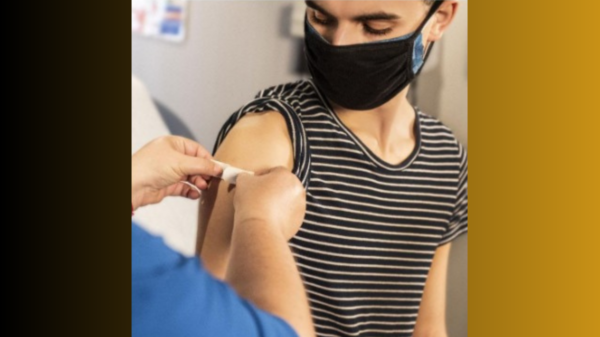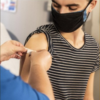By Charlotte Huff

Shunda Williams was recovering from COVID-19 pneumonia in the hospital at Texas Health Presbyterian Dallas last year, still requiring oxygen, when she realized she couldn’t manage her fork.
“My hand kept doing this,” said Williams, 46, sitting recently in her Dallas apartment, holding up her right hand, then abruptly letting it drop. “I had no control over it. It was just dangling, falling.”
After several tests, including magnetic resonance imaging (MRI), a physician told Williams that she had experienced “10 ministrokes,” she recalled. While there’s no way to know for sure, the physician believed the virus had contributed along with possibly her other medical conditions, including diabetes, Williams said.
More than two years after the emergence of SARS-CoV-2, researchers and physicians are still trying to sort out to what extent the infection boosts the risk of stroke, and for how long that risk lasts.
The likelihood of having a stroke around the time of infection is still relatively low — 1.4% according to a meta-analysis of 61 studies — but may require weeks to months of recovery. Williams finally returned home to her 12-year-old daughter, Zaniya, after six weeks of hospitalization, first to treat the virus and later for stroke-related rehabilitation.
Now a study, published online Feb. 7 in Nature Medicine, indicates that higher stroke vulnerability might extend through the first year after a bout with COVID-19.
The analysis, which compared 153,760 patients treated through the Veterans Affairs system with those who didn’t contract the virus, found that the likelihood of a stroke within the first year was 52% higher, resulting in four additional strokes per 1,000 patients.
Although strokes were more likely in patients who were most severely ill, they also occurred in those who had mild symptoms and didn’t need to be hospitalized, said Dr. Ziyad Al-Aly, the study’s senior author and chief of research and development at the Veterans Affairs St. Louis Health Care System in Missouri.
“That’s really important because that’s really the majority of people with COVID-19,” he said. “One of the implications of the findings of this study is that now we need to start thinking about COVID-19 as a cardiovascular risk factor.”
While the Nature Medicine findings are intriguing, they don’t show whether the strokes occurred shortly after the infection or throughout the first year, said Dr. James de Lemos, a professor of cardiology at UT Southwestern Medical Center in Dallas, who studies cardiovascular risk and the virus.
”This study raises the possibility that there could be effects that last longer than most of us would have predicted,” de Lemos said. “But much more study is needed before we can determine if this is true. And even if it is true, it looks like the risks for any one individual are very small.”
Understanding infection and stroke
A short-term risk of stroke also has been identified in patients with other serious infections, including influenza and sepsis, said Dr. Mitchell Elkind, professor of neurology and epidemiology at New York City’s Columbia University, who studies stroke and infectious disease.
For instance, research has shown that stroke is more likely during the first several months after sepsis, he said. “I think that’s consistent with what’s being seen here with regard to COVID.”
The causes of stroke and other cardiovascular conditions are still being examined but appear in part to be related to the inflammatory impact of the coronavirus throughout the body, including the lining of the blood vessels, de Lemos said. By irritating the protective lining of those vessels, that inflammation might encourage the formation of clots, he said.
Another recent analysis, which looked at strokes in 37,379 adults ages 65 and older with COVID-19, found that the greatest likelihood was during the first three days after diagnosis when it was 10 times higher.
That risk quickly declined and was just 9% higher 15 to 28 days after diagnosis compared with the control period, according to the findings, published online Feb. 3 in the journal Neurology. Both the Neurology and Nature Medicine studies stopped enrolling patients in early 2021, before the vaccine became widely available.
Dr. Gabriel de Erausquin, a neurologist who studies long-COVID and the brain at UT Health Science Center at San Antonio, said he’s not surprised by the Nature Medicine findings, given that he’s seen “unexpected strokes in relatively young or healthier individuals.”
These adults are typically middle age and don’t have obvious risk factors, such as diabetes or obesity, he said. De Erausquin, who doesn’t treat patients hospitalized with the virus, said the strokes he’s seen are “usually during recovery, and by that, I mean in the months following the acute infection.”
Clinicians also have recounted unusual stroke cases to Brian Abraham, a regional chief executive officer for the Albuquerque-based rehabilitation chain ClearSky Health. His administrative oversight includes two Dallas-Fort Worth hospitals..
At one of them, ClearSky Rehabilitation Hospital of Flower Mound, clinicians have treated at least three patients in the past nine months with similar stories, he said. They had mild cases of the viral infection and were quarantined at home when they collapsed with what turned out to be a stroke, he said. “None of those patients were over the age of 47,” Abraham said.
Stroke rehabilitation can take longer with these patients, if they’re still recovering from the virus because they often require numerous rest breaks, Abraham said. “Something as simple as sitting up on the edge of the bed can drop their oxygen saturation rates to the 50s and 60s percentiles,” he said.
A tougher recovery
After her ministrokes, Shunda Williams completed three weeks of inpatient rehabilitation followed by two months of outpatient rehabilitation once she returned home.
During inpatient rehabilitation, Williams worked on improving the weakness in her right arm and leg, along with her balance, so she could shower and dress herself safely, said Jason Mathew, a Texas Health Dallas occupational therapist.
Mathew remembers Williams for her big smile and fierce determination to get better. “She was concerned about just getting home to her daughter and being able to take care of her,” he said.
Those who have had COVID-19 should alert their physician so they can be more proactive about other risk factors, such as controlling blood pressure, said Al-Aly, who authored the Nature Medicine study.
But Elkind disagreed that the virus at this point should be considered a long-term risk factor, as any heightened vulnerability is likely to be short term, he said. Plus, Elkind said, “for any one individual, it’s still a very unlikely event to occur.”
People should focus instead on healthy eating habits, exercise and regular checkups, including blood pressure, said Elkind, also the immediate past president of the American Heart Association.
UTSW researchers led a study, published earlier this year in the American Heart Journal, that found the percentage of patients with uncontrolled high blood pressure increased from 15% to 19%, compared with pre-pandemic.
Williams’ road hasn’t been the easiest, even after she went home last April.
She learned in late 2021 that she had suffered a silent heart attack at some point, and physicians implanted two stents to open clogged blood vessels. But Williams, who also has an adult son, doesn’t report any lingering stroke effects, other than occasional memory lapses. She makes more lists these days.
She didn’t return to her warehouse job and works a customer service position from home, relishing the time with her daughter. When she crossed her own threshold, Williams still needed oxygen and intravenous antibiotics. But she was home.
“When I was in there [the hospital] with COVID, I was like, `Oh, Lord, please don’t take me. I have a 12-year-old to raise. Just let me make it out of here.’”
Charlotte Huff, a Fort Worth-based journalist, covers medical and business stories. Her work has appeared in Kaiser Health News, Nature, Slate, STAT and Texas Monthly, among other publications. Follow her on Twitter at @Charlotte_Huff.









You must be logged in to post a comment Login